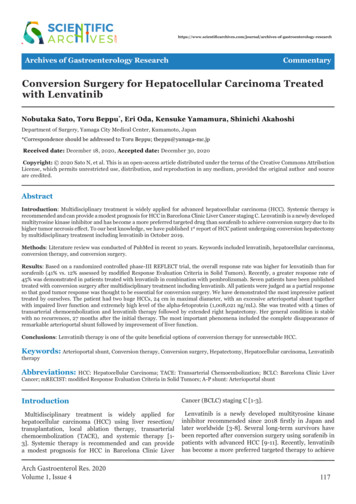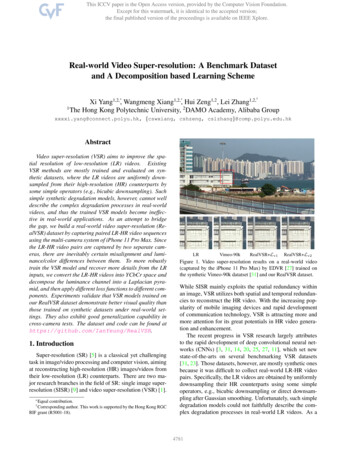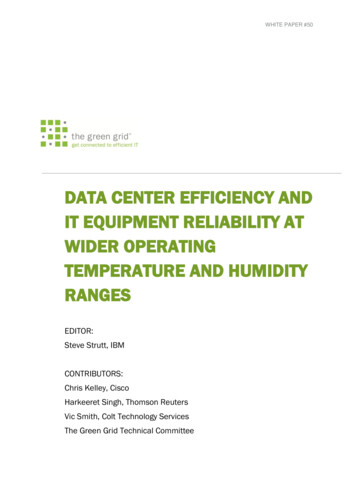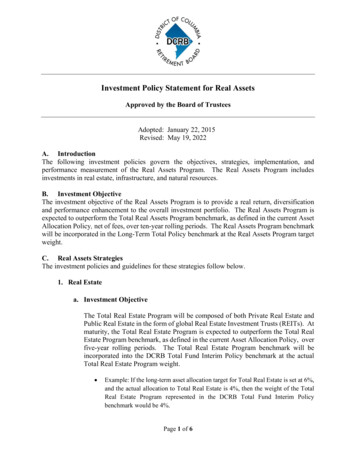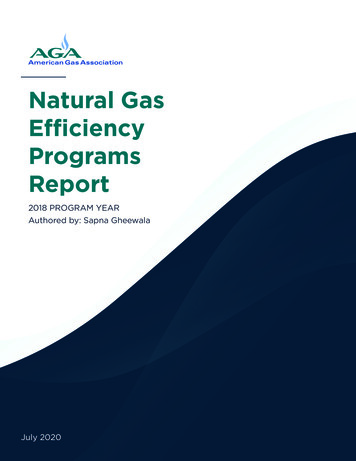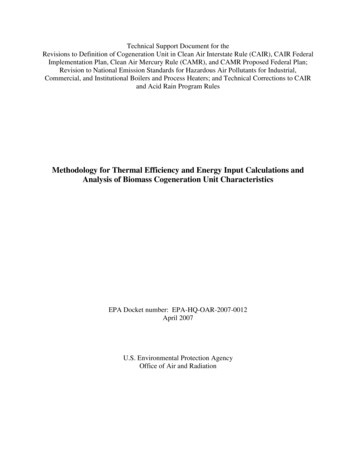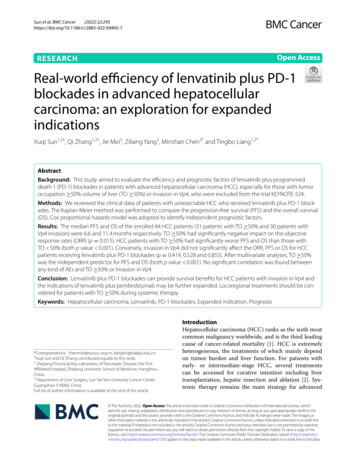
Transcription
(2022) 22:293Sun et al. BMC en AccessRESEARCHReal-world efficiency of lenvatinib plus PD-1blockades in advanced hepatocellularcarcinoma: an exploration for expandedindicationsXuqi Sun1,2†, Qi Zhang1,2†, Jie Mei3, Ziliang Yang3, Minshan Chen3* and Tingbo Liang1,2*AbstractBackground: This study aimed to evaluate the efficiency and prognostic factors of lenvatinib plus programmeddeath 1 (PD-1) blockades in patients with advanced hepatocellular carcinoma (HCC), especially for those with tumoroccupation 50% volume of liver (TO 50%) or invasion in Vp4, who were excluded from the trial KEYNOTE-524.Methods: We reviewed the clinical data of patients with unresectable HCC who received lenvatinib plus PD-1 blockades. The Kaplan-Meier method was performed to compare the progression-free survival (PFS) and the overall survival(OS). Cox proportional hazards model was adopted to identify independent prognostic factors.Results: The median PFS and OS of the enrolled 84 HCC patients (31 patients with TO 50% and 30 patients withVp4 invasion) were 6.6 and 11.4 months respectively. TO 50% had significantly negative impact on the objectiveresponse rates (ORR) (p 0.015). HCC patients with TO 50% had significantly worse PFS and OS than those withTO 50% (both p value 0.001). Conversely, invasion in Vp4 did not significantly affect the ORR, PFS or OS for HCCpatients receiving lenvatinib plus PD-1 blockades (p 0.419, 0.528 and 0.855). After multivariate analyses, TO 50%was the independent predictor for PFS and OS (both p value 0.001). No significant correlation was found betweenany kind of AEs and TO 50% or invasion in Vp4.Conclusion: Lenvatinib plus PD-1 blockades can provide survival benefits for HCC patients with invasion in Vp4 andthe indications of lenvatinib plus pembrolizumab may be further expanded. Locoregional treatments should be considered for patients with TO 50% during systemic therapy.Keywords: Hepatocellular carcinoma, Lenvatinib, PD-1 blockades, Expanded indication, Prognosis*Correspondence: chenmsh@sysucc.org.cn; liangtingbo@zju.edu.cn†Xuqi Sun and Qi Zhang contributed equally to this work.2Zhejiang Provincial Key Laboratory of Pancreatic Disease, the FirstAffiliated Hospital, Zhejiang University School of Medicine, Hangzhou,China3Department of Liver Surgery, Sun Yat-Sen University Cancer Center,Guangzhou 510060, ChinaFull list of author information is available at the end of the articleIntroductionHepatocellular carcinoma (HCC) ranks as the sixth mostcommon malignancy worldwide, and is the third leadingcause of cancer-related mortality [1]. HCC is extremelyheterogeneous, the treatments of which mainly dependon tumor burden and liver function. For patients withearly- or intermediate-stage HCC, several treatmentscan be accessed for curative intention including livertransplantation, hepatic resection and ablation [2]. Systemic therapy remains the main strategy for advanced The Author(s) 2022. Open Access This article is licensed under a Creative Commons Attribution 4.0 International License, whichpermits use, sharing, adaptation, distribution and reproduction in any medium or format, as long as you give appropriate credit to theoriginal author(s) and the source, provide a link to the Creative Commons licence, and indicate if changes were made. The images orother third party material in this article are included in the article’s Creative Commons licence, unless indicated otherwise in a credit lineto the material. If material is not included in the article’s Creative Commons licence and your intended use is not permitted by statutoryregulation or exceeds the permitted use, you will need to obtain permission directly from the copyright holder. To view a copy of thislicence, visit http:// creat iveco mmons. org/ licen ses/ by/4. 0/. The Creative Commons Public Domain Dedication waiver (http:// creat iveco mmons. org/ publi cdoma in/ zero/1. 0/) applies to the data made available in this article, unless otherwise stated in a credit line to the data.
Sun et al. BMC Cancer(2022) 22:293HCC, which accounts for approximately 80% of HCCpatients at diagnosis [2, 3]. In addition to sorafenib, theinitial approved first-line drug for advanced HCC, lenvatinib was later approved as the first-line treatment forunresectable HCC due to its noninferior efficiency tosorafenib [4, 5].In recent years, immunotherapies including programmed death 1 (PD-1) blockades have changed thelandscape of treatments in advanced HCC [6]. Thepromising survival benefits from PD-1 blockades elicitclinical trials focusing on the combination of immunotherapies and targeted drugs such as atezolizumabplus bevacizumab, which was granted as prioritizedfirst-line regimen for advanced HCC [6, 7]. Anothercombination therapy of lenvatinib plus pembrolizumab(KEYNOTE-524) also achieved the objective responserate (ORR) of 36.0% for unresectable HCC in phase Ibstudy, and its phase III trial LEAP-002 is currently underway [8]. To enroll patients most likely to benefit from thetesting regimen, KEYNOTE-524 excluded patients withHCC having 50% liver occupation or Vp4 invasion [8].In clinical practice, however, portal vein tumor thrombosis (PVTT) and high HCC burden exist in approximately40% of patients at diagnosis due to the conceal onset ofHCC [9, 10]. The prognosis of these patients remainspoor, and therapeutic strategies are limited for them [9,11]. For HCC patients with PVTT, systemic therapy isthe only first-line therapy currently, but the expandingdrugs provide limited data for HCC patients with Vp4invasion or tumor occupation 50% volume of liver (TO 50%) [12].In this study, we investigated the efficiency of lenvatinib plus PD-1 blockades in advanced HCC patients,especially for those with TO 50% or tumor thrombosis in Vp4. This research can complement the results ofKEYNOTE-524 for patients with advanced HCC.MethodsPatientsIn this retrospective study, we reviewed HCC patientsreceiving lenvatinib plus PD-1 blockades in Sun Yatsen University Cancer Center and the First AffiliatedHospital, Zhejiang University School of Medicinefrom January 2019 to June 2021. The inclusion criteria were as follows: 1) pathologically or clinically diagnosed as HCC according to the ESMO guidelines [2];2) with baseline imaging of HCC within 6 weeks beforereceiving lenvatinib plus PD-1 blockades and 3) withthe Eastern Co-operative Oncology Group performance status score of 0–1. The patients were excludedif they had received immunotherapy before. Eventually, 84 HCC patients were included for further analysis. The demographic and clinical data were collectedPage 2 of 8including age, gender, the status of hepatitis B surfaceantigen (HBsAg), Child Pugh class, tumor size, extrahepatic metastasis, serum alpha-fetoprotein (AFP) levels and adverse events (AEs). The invasion of Vp4 wasdefined as the thrombosis into the main trunk and/orthe contralateral portal branch of the primary lesion[12]. Whether TO 50% was independently evaluatedby two doctors. If their evaluation results were inconsistent, the third senior doctor should independentlyevaluate the tumor burden and make the final judgement. This study was approved by the Ethical Committee of Sun Yat-sen University Cancer Center and theFirst Affiliated Hospital, Zhejiang University School ofMedicine.Systemic treatment and follow‑upAll the patients received lenvatinib (12 mg/day for bodyweight 60 kg or 8 mg/day for bodyweight 60 kg) plusPD-1 blockades. PD-1 blockades were intravenouslyadministered at the standard dose as follows: pembrolizumab 200 mg (n 10), toripalimab 240 mg (n 37),sintilimab 200 mg (n 23), nivolumab 100 mg (n 13)or camrelizumab 200 mg (n 1) every 3 weeks. Abdominal contrast enhanced computer tomography (CT) ormagnetic resonance imaging (MRI) and chest enhancedCT were performed every 6–8 weeks during treatment.Tumor response was evaluated according to the ResponseEvaluation Criteria in Solid Tumors (RECIST 1.1) [13].The ORR was the proportion of patients who confirmedcomplete response (CR) or partial response (PR). TheAEs were assessed based on the Common TerminologyCriteria for Adverse Events (CTCAE v5.0).Statistical analysisThe Kaplan-Meier method with log-rank test was performed to estimate the overall survival (OS) and progression-free survival (PFS). The OS was estimated from thedate of initial combination therapy to the date of death orlast follow-up. The PFS was calculated from the date offirst dose of combination therapy to the date of progression or death. Chi-square test was used to compare baseline characteristics between subgroups classified by thepresence of TO 50% or invasion in Vp4. Binary logistic regression analysis was used to evaluate the association between the ORR and tumor burden or invasion inVp4. Univariate and multivariate Cox regression analyseswere adopted to identify independent prognostic factorsfor OS and PFS. A two-tailed P value less than 0.05 wasconsidered statistically significant. All statistical analyseswere performed with the IBM SPSS, version 26.0 and theR software version 3.5.0.
Sun et al. BMC Cancer(2022) 22:293Page 3 of 8ResultsBaseline characteristicsThe baseline characteristics of 84 patients are shownin Table 1. The median age was 53 years for the wholegroup. The patients were mainly male (n 69). Mostpatients were infected with hepatitis B virus. Amongthe whole group, 85.7% (72/84) patients were ChildPugh A class, and the remaining were Child Pugh Bclass. 81.0% (68/84) patients were BCLC C stage andthe others were BCLC B stage. In 42 patients with extrahepatic metastases, 29 patients had lung metastases,14 patients had lymph node metastases, five patientshad bone metastasis, three patients had peritonealmetastasis, one patient had renal metastasis and onepatient had adrenal metastasis. In terms of treatmentsprior to lenvatinib plus PD-1 blockades, six patientsreceived transarterial chemoembolization (TACE) plussorafenib, three patients received sorafenib, one patientreceived apatinib and 27 patients received TACE. Theshortest duration between lenvatinib plus PD-1 blockades and TACE was 1.17 months. In this cohort, 31HCC patients had TO 50%, 30 HCC patients hadtumor thrombosis in Vp4, and 12 patients had bothTO 50% and tumor thrombosis in Vp4. Higher proportion of patients with TO 50% were Child Pugh Bclass compared with those with TO 50% (p 0.021).Patients with HCC invasion in Vp4 were younger thanthose without Vp4 invasion (p 0.005). In addition,tumor thrombosis in Vp4 was negatively correlatedwith receiving prior systemic treatment (p 0.012).Among 54 patients without Vp4 invasion, 37.0% (20/54)patients had Vp3 invasion, 7.4% (4/54) patients had Vp2invasion and 55.6% (30/54) patients had no macrovascular invasion.Table 1 Baseline characteristics of enrolled HCC patientsVariableSample sizeMedian age (range)All patientsn 8453 (25–78)Tumor occupation 50%Invasion with Vp4YesYesn 3151 (29–78)Non 5353 (25–72)n 3051 (29–78)Non 5453 (25–78)SexMale69 (82.1)25 (80.6)44 (83.0)25 (83.3)44 (81.5)Female15 (17.9)6 (19.4)9 (17.0)5 (16.7)10 (18.5)Positive71 (84.5)26 (83.9)45 (84.9)28 (93.3)43 (79.6)Negative13 (15.5)5 (16.1)8 (15.1)2 (6.7)11 (20.4)HBsAgChild-Pugh classA72 (85.7)23 (74.2)49 (92.5)25 (83.3)47 (87.0)B12 (14.3)8 (25.8)4 (7.5)5 (16.7)7 (13.0)BCLC stageB15 (17.9)4 (12.9)11 (20.8)0 (0.0)15 (27.8)C69 (82.1)27 (87.1)42 (79.2)30 (100.0)39 (72.2)Extrahepatic metastasisYes42 (50.0)13 (41.9)29 (54.7)12 (40.0)30 (55.6)No42 (50.0)18 (58.1)24 (45.3)18 (60.0)24 (44.4)AFP level 400 μg/mlYes45 (53.6)20 (64.5)25 (47.2)19 (63.3)26 (48.1)No39 (46.4)11 (35.5)28 (52.8)11 (36.7)28 (51.9)Prior systemic treatmentYes10 (11.9)5 (16.1)5 (9.4)0 (0.0)10 (18.5)No74 (88.1)26 (83.9)48 (90.6)30 (100.0)44 (81.5)Prior TACEYes33 (39.3)9 (29.0)24 (45.3)8 (26.7)25 (46.3)No51 (60.7)22 (71.0)29 (54.7)22 (73.3)29 (53.7)Maximum diameter of HCC 5 cmYes64 (76.2)30 (96.8)34 (64.2)27 (90.0)37 (68.5)No20 (23.8)1 (3.2)19 (35.8)3 (10.0)17 (31.5)
Sun et al. BMC Cancer(2022) 22:293Analysis of PFS and ORRThe median follow-up time was 17.12 months(16.25 months for patients with Vp4 invasion,18.93 months for patients without Vp4 invasion, 14.33 months for patients with TO 50% and18.93 months for patients with TO 50%). Duringfollow-up, 76.2% (64/84) patients suffered from progression, and the median PFS was 6.6 months (95%confidence interval (CI), 4.3–8.9 months). The PFS wassimilar between patients receiving pembrolizumab andthose receiving other PD-1 blockades (p 0.328). TheORR was 20.2% (17/84) with one patient achievingCR, 16 patients achieving PR, 17 patients having stabledisease, 17 patients having progressive disease and 33Page 4 of 8patients without regular follow-up. HCC patients withTO 50% had significantly lower ORR than those withTO 50% (p 0.016). No significant difference wasfound between HCC patients with and without tumorthrombosis in Vp4 in terms of ORR (p 0.278). Wefurther compared the prognosis between patients classified by the presence of TO 50% or invasion in Vp4.The PFS of patients with TO 50% was significantlyworse than that of patients with TO 50% (p 0.001)(Fig. 1A). Conversely, no significant difference wasfound between patients with and without Vp4 invasion(p 0.528) (Fig. 2A). According to the results of multivariate analyses, only age and TO 50% had significantimpact on the PFS of HCC patients receiving lenvatinibFig. 1 The survival curves of HCC patients with and without tumor occupation 50% volume of live (TO 50%). TO 50% had significantlynegative impact on the PFS (A) and OS (B) (both p value 0.001)Fig. 2 The survival curves of HCC patients with and without tumor thrombosis in Vp4. There was no significant difference between HCC patientswith and without Vp4 invasion in terms of PFS (A) and OS (B) (p 0.528 and 0.855)
Sun et al. BMC Cancer(2022) 22:293Page 5 of 8plus PD-1 blockades (p 0.002 and 0.001). Detaileddata are listed in Table 2.Analysis of OSThe median OS was 11.4 months (95%CI, 7.9–14.9 months), and 57.1% (48/84) patients died during follow-up. No significant difference was found inOS between patients receiving pembrolizumab andthose receiving other PD-1 blockades (p 0.639). Themedian OS was 18.1 months for patients with TO 50%,6.1 months for patients with TO 50%, 11.63 monthsfor patients without Vp4 invasion and 11.39 months forpatients with Vp4 invasion. The 1-year survival rate was60.7% for patients with TO 50, 42.5% for patients withTO 50, 56.9% for patients without Vp4 invasion and54.5% for patients with Vp4 invasion. As shown in survival curves, patients with TO 50% had significantlyworse OS than those with TO 50% (p 0.001) (Fig. 1B).In terms of Vp4 invasion, there was no significant difference in OS between HCC patients with and without invasion in Vp4 (p 0.855) (Fig. 2B). Although both age andTO 50% showed significant association with OS in univariate analyses (p 0.040 and 0.001), only TO 50%was the independent predictors for OS after multivariateanalyses (p 0.001). Detailed data are shown in Table 2.AEsFor patients with adequate following medical laboratorydata, we assessed objective AEs of lenvatinib plus PD-1blockades. The summary of AEs is presented in Table 3.In general, the most common AEs of any grade were bilirubin elevation (56.0%), elevated aspartate aminotransferase (55.1%) and proteinuria (52.6%). No significantTable 3 Summary of safetyPercentages(%)Elevated aspartate aminotransferaseAny grade55.1Grade 318.4Any grade56.0Grade 312.0Any grade41.4Grade 30Any grade26.4Grade 33.8Any grade52.6Grade 32.6Bilirubin n was found between any kind of AEs and TO 50% or Vp4 invasion.DiscussionIn this study, we compared the efficiency of lenvatinibplus PD-1 blockades between HCC patients with andwithout TO 50% or tumor thrombosis in Vp4, andwe found that patients with TO 50% had significantlyworse PFS or OS compared to those with TO 50%. Inaddition, no significant difference was found betweenpatients with and without invasion in Vp4 in terms ofPFS and OS. To our knowledge, this was the first study toTable 2 Univariate and multivariate analyses of prognostic factors for PFS and OSPFSOSUnivariateVariablesAge, yearsSexHR (95%CI) 50FemaleMultivariateUnivariatePHR (95%CI)P0.49 (0.30–0.80)0.0040.45 (0.27–0.76)0.0021.57 (0.85–2.89)0.152HR (95%CI)MultivariatePHR (95%CI)P0.55 (0.31–0.97)0.0400.58 (0.33–1.04)0.0650.94 (0.44–2.00)0.8633.90 (2.14–7.12) 0.001HBsAgPositive1.02 (0.51–2.08)0.9471.10 (0.47–2.60)0.823Child Pugh classB1.19 (0.59–2.40)0.6361.83 (0.89–3.79)0.103BCLC stageCExtrahepatic metastasisYesAFP level 400μg/mlPrior systemic treatment0.76 (0.40–1.44) 0.3971.23 (0.75–2.01)0.418Yes1.02 (0.62–1.67)0.9411.01 (0.57–1.78)0.9812.00 (0.98–4.06)0.0571.49 (0.70–3.19)0.304Prior TACEYesYes1.45 (0.78–2.69)0.236Yes2.50 (1.49–4.18) 0.001Yes0.85 (0.50–1.43)0.528Invasion with Vp40.4130.346YesMaximum diameter of 5 cmTumor occupation 50%1.40 (0.63–3.12)1.32 (0.74–2.33)1.17 (0.71–1.93) 0.5470.69 (0.38–1.25) 0.2212.66 (1.57–4.49) 0.0011.86 (0.87–3.98)0.1103.98 (2.19–7.22) 0.0010.95 (0.52–1.72)0.855
Sun et al. BMC Cancer(2022) 22:293evaluate the utility of lenvatinib plus PD-1 blockades inHCC patients with TO 50% or tumor invasion in Vp4,who were excluded from the KEYNOTE-524, the phaseIb study of lenvatinib plus pembrolizumab.With the conceal onset of HCC, most HCC patientsare diagnosed at intermediate or advanced stage, andhigh tumor volume burden and PVTT are common inadvanced HCC [9, 14]. The prognosis of HCC patientswith PVTT remains dismal, whose OS is only 2–4 monthswith best supportive care [15, 16]. Although oncologistshave explored the utility of hepatectomy and locoregionaltreatments in HCC patients with tumor thrombosis inVp4, no survival benefits are observed for hepatectomyand high risk of hepatic failure limits the application ofTACE in HCC patients with invasion in the main portaltrunk or the first-order branches [17, 18]. According tocurrent clinical guidelines, systemic therapy is recommended as the first-line treatment for HCC patients withPVTT [2]. The restrictions for sorafenib do not includeportal vein invasion, however, lenvatinib is not recommended for patients with main portal vein invasion [2].Kuzuya et al. have reported that lenvatinib can achievebetter efficiency than sorafenib for HCC patients withVp3/4 invasion, which suggested the application valueof lenvatinib in HCC with Vp3/4 invasion [19]. AlthoughChoi et al. found that hepatic arterial infusion chemotherapy (HAIC) can achieve better ORR and OS thansorafenib in HCC patients with PVTT, few studies haveevaluated the efficiency of lenvatinib plus PD-1 blockadesfor HCC patients with tumor thrombosis in Vp4 [20].Lenvatinib, an oral multikinase inhibitor, targets multiple molecules such as vascular endothelial growth factor receptor 1–3 and fibroblast growth factor [8, 21].PD-1 blockades have revolutionized the treatments ofadvanced HCC in recent years, which can reactive thesuppressed immune microenvironment [6]. Lenvatiniband PD-1 blockades have synergistic anti-tumor effects.Lenvatinib can decrease immunosuppressive impactsof HCC, which in turn improve the anti-tumor effectsof PD-1 blockades [22]. The results of phase Ib studyof lenvatinib plus pembrolizumab showed promisingsurvival benefits for unresectable HCC, and subgroupanalyses indicated that the ORR was consistent betweenpatients with and without macroscopic portal vein invasion (37.5% vs 35.7%) [8]. To enroll patients most likelyto benefit from this testing regimen, HCC patients withTO 50% or Vp4 invasion were excluded from thistrial, however, these patients account for a majority ofadvanced HCC patients. Previous studies have found theOS of HCC patients with TO 50% or Vp4 invasion wasworse than that of HCC patients without TO 50% orVp4 invasion when receiving lenvatinib alone [12, 23, 24].As for PFS, there is no consistent conclusion.Page 6 of 8Although previous researches have evaluated potentialof lenvatinib for the expanded indication, these studies did not further assess the impact of TO 50% andVp4 invasion respectively. In current study, we foundthat there was no significant difference between HCCpatients with and without Vp4 invasion in terms of ORR,PFS and OS when receiving lenvatinib plus PD-1 blockades. The ORR was 33.3% in this study, which is similarwith the ORR reported by Huang et al. [25]. In addition, they also evaluated organ-specific response rates(OSRR) for patients with unresectable HCC receivingfirst-line lenvatinib plus PD-1 antibodies, and the OSRRof macrovascular tumor thrombi could reach to 54.5%,which was higher than that of lung metastases (37.5%),intrahepatic tumors (32.8%) and lymph node metastases(33.3%) [25]. These results indicate that tumor thrombosis in portal vein has better sensitivity to the combination therapy compared with HCCs in other sites, whichcan explain why the Vp4 invasion did not significantlyaffect the efficiency of lenvatinib plus PD-1 blockades inthis study. The median OS and 1-year survival rate in ourstudy was worse than those in the trial KEYNOTE-524which may be due to the heavier tumor burden and relatively poor liver function of enrolled patients [8].As for tumor burden, we found HCC patients with TO 50% had significantly worse ORR, PFS and OS comparedwith those with TO 50%. These results indicate that lenvatinib plus PD-1 blockades may not be the optimal treatment for HCC patients with TO 50%. Similarly, Huanget al. have found that the ORR of combined lenvatinib withPD-1 antibody is worse in intrahepatic lesions than vascular invasion or extrahepatic metastases [25]. Another studyalso found that intrahepatic tumors are less responsive toimmune checkpoint inhibitors than extrahepatic metastases in HCC patients [26]. The anti-tumor ability of PD-1blockades mainly depends on reactivating exhausted Tcells, and the immune microenvironments of differentorgans can affect the therapeutic effects of PD-1 blockades [26]. Due to the special physiological function, theliver is consistently exposed to new antigens, which createsthe tolerogenic microenvironment of the liver [27]. Studies have also found liver metastases have lower responserates to anti-PD-1 immunotherapies than primary or othermetastatic lesions in other solid tumors such as melanomaand non-small cell lung cancer [28]. Besides, high tumorvolume might limit locoregional concentration of drugs,which could compromise the efficiency of lenvatinib andPD-1 blockades. Therefore, systemic therapy alone may benot sufficient for large HCC, and locoregional treatmentssuch as TACE or HAIC should be considered simultaneously during systemic treatments.There are several limitations for this study. First, it wasa retrospective study, which may lead to unintentional
Sun et al. BMC Cancer(2022) 22:293biases and lack of some information for the evaluationof AEs. To avoid subjective recall biases, we only evaluated the laboratory AEs for patients with laboratoryfollow-up records, which caused the higher rates of AEsin this study since the follow-up laboratory tests weregiven based on the considerations of physicians. Second,PD-1 blockades were from different manufacturers, butpatients receiving pembrolizumab had similar prognosiswith those receiving other PD-1 blockades. The resultstherefore should be genuine. Third, the ORR of lenvatinib plus PD-1 blockades in this study was lower thanthose reported in previous studies, which might be dueto 33 patients without regular follow-up for evaluatingefficiency [8, 25]. Among 51 patients receiving regularfollow-up, the response rate was 33.3% (17/51). Forth,the sample size was limited for this research, and mostpatients were infected with HBV. Further multicenterstudy with sufficient sample size is expected to evaluatewhether these results can be applied to HCC patientswith different etiologies.In conclusion, lenvatinib plus PD-1 blockades canprovide survival benefits for HCC patients with tumorthrombosis in Vp4, which indicates the indicationsof lenvatinib plus pembrolizumab may be furtherexpanded. On the contrary, this combination regimenmay not be sufficient enough for HCC patients withTO 50%, and other locoregional treatments should beconsidered simultaneously during systemic treatments.AbbreviationsHCC: Hepatocellular carcinoma; PD-1: Programmed death 1; ORR: Objectiveresponse rate; PVTT: Portal vein tumor thrombosis; TO 50%: Tumor occupation 50%; HBsAg: Hepatitis B surface antigen; AFP: Alpha-fetoprotein; AEs:Adverse events; CT: Computer tomography; MRI: Magnetic resonance imaging; RECIST 1.1: Response Evaluation Criteria in Solid Tumors 1.1; CR: Completeresponse; PR: Partial response; CTCAE v5.0: Common Terminology Criteria forAdverse Events version 5.0; OS: Overall survival; PFS: Progression-free survival;CI: Confidence interval; TACE: Transarterial chemoembolization; HAIC: Hepaticarterial infusion chemotherapy; OSRR: Organ-specific response rates.AcknowledgementsNone.Animal research (ethics)Not Applicable.Consent to publish (ethics)Not Applicable.Plant reproducibilityNot Applicable.Clinical trials registrationNot Applicable.Authors’ contributionsT.L, M.C., X.S. and Q.Z. conceived and designed the study. X.S., Q.Z., J.M. andZ.Y. participated in the acquisition of the data. X.S., Q.Z. and J.M. participatedin the analysis, or interpretation of the data. X.S., Q.Z. and T.L. participated inthe drafting of the article or critical revision for important intellectual content.Page 7 of 8All authors were involved in the approval of the version to be published andagreement to be accountable for all aspects of the work.FundingThis study received no funding support.Availability of data and materialsThe datasets used during the current study are available from the corresponding author on reasonable request.DeclarationsEthics approval and consent to participateThis study was approved by the institutional review board of Sun Yat-senUniversity Cancer Center and the First Affiliated Hospital, Zhejiang UniversitySchool of Medicine as a retrospective study, and the requirement for informedconsent was waived. All procedures performed in studies involving humanparticipants were in accordance with the ethical standards of the1964 Helsinkideclaration and its later amendments.Consent for publicationNone.Competing interestsThe authors declare that they have no competing interests.Author details1Department of Hepatobiliary and Pancreatic Surgery, the First AffiliatedHospital, Zhejiang University School of Medicine, Hangzhou 310006, China.2Zhejiang Provincial Key Laboratory of Pancreatic Disease, the First Affiliated Hospital, Zhejiang University School of Medicine, Hangzhou, China.3Department of Liver Surgery, Sun Yat-Sen University Cancer Center, Guangzhou 510060, China.Received: 19 January 2022 Accepted: 10 March 2022References1. Sung H, Ferlay J, Siegel RL, Laversanne M, Soerjomataram I, Jemal A, et al.Global cancer statistics 2020: GLOBOCAN estimates of incidence andmortality worldwide for 36 cancers in 185 countries. CA Cancer J Clin.2021;71(3):209–49.2. Vogel A, Cervantes A, Chau I, Daniele B, Llovet JM, Meyer T, et al. Hepatocellular carcinoma: ESMO clinical practice guidelines for diagnosis,treatment and follow-up. Ann Oncol. 2018;29(Suppl 4):iv238–55.3. Forner A, Reig M, Bruix J. Hepatocellular carcinoma. Lancet.2018;391(10127):1301–14.4. Kudo M, Finn RS, Qin S, Han KH, Ikeda K, Piscaglia F, et al. Lenvatinibversus sorafenib in first-line treatment of patients with unresectablehepatocellular carcinoma: a randomised phase 3 non-inferiority trial.Lancet. 2018;391(10126):1163–73.5. Llovet JM, Ricci S, Mazzaferro V, Hilgard P, Gane E, Blanc JF, et al. Sorafenibin advanced hepatocellular carcinoma. N Engl J Med. 2008;359(4):378–90.6. Pinter M, Jain RK, Duda DG. The current landscape of immune checkpoint blockade in hepatocellular carcinoma: a review. JAMA Oncol.2021;7(1):113–23.7. Finn RS, Qin S, Ikeda M, Galle PR, Ducreux M, Kim TY, et al. Atezolizumabplus bevacizumab in unresectable hepatocellular carcinoma. N Engl JMed. 2020;382(20):1894–905.8. Finn RS, Ikeda M, Zhu AX, Sung MW, Baron AD, Kudo M, et al. Phase Ibstudy of Lenvatinib plus pembrolizumab in patients with unresectablehepatocellular carcinoma. J Clin Oncol. 2020;38(26):2960–70.9. Liu PH, Huo TI, Miksad RA. Hepatocellular carcinoma with portal veintumor involvement: best management strategies. Semin Liver Dis.2018;38(3):242–51.10. Minagawa M, Makuuchi M. Treatment of hepatocellular carcinomaaccompanied by portal vein tumor thrombus. World J Gastroenterol.2006;12(47):7561–7.
Sun et al. BMC Cancer(2022) 22:29311. Kuo YH, Wu IP, Wang JH, Hung CH, Rau KM, Chen CH, et al. The outcomeof sorafenib monotherapy on hepatocellular carcinoma with portal veintumor thrombosis. Investig New Drugs. 2018;36(2):307–14.12. Chuma M, Uojima H, Hiraoka A, Kobayashi S, Toyoda H, Tada T, et al.Analysis of efficacy of lenvatinib treatment in highly advanced hepatocellular carcinoma with tumor thrombus in the main trunk of the portal veinor tumor with more than 50% liver occupation: a multicenter analysis.Hepatol Res. 2021;51(2):201–15.13. Eisenhauer EA, Therasse P, Bogaerts J, Schwartz LH, Sargent D, Ford R,et al. New response evaluation criteria in solid tumours: revised RECISTguideline (version 1.1). Eur J Cancer. 2009;45(2):228–47.14. Kudo M, Matsui O, Izumi N, Iijima H, Kadoya M, Imai Y, et al. JSH consensus-based clinical practice guidelines for the Management of Hepatocellular Carcinoma: 2014 update by the liver Cancer study Group of Japan.Liver Cancer. 2014;3(3–4):458–68.15. Chan SL, Chong CC, Chan AW, Poon DM, Chok KS. Management ofhepatocellular carcinoma with portal vein tumor thrombosis: review andupdate at 2016. World J Gastroenterol. 2016;22(32):7
Sun et al. BMC Cancer Page 2 of 8 HCC, which accounts for approximately 80% of HCC patients at diagnosis [3]. In addition to sorafenib, the 2, initial approved rst-line drug for advanced HCC, len-vatinib was later approved as the rst-line treatment for unresectable HCC due to its noninferior eciency to sorafenib [4, 5].
